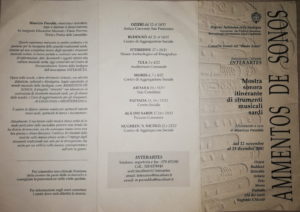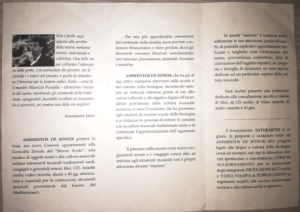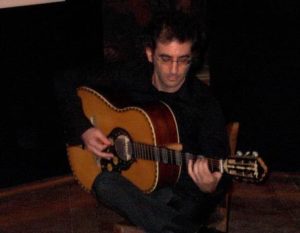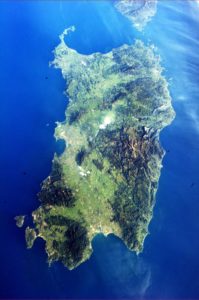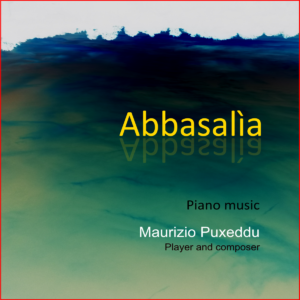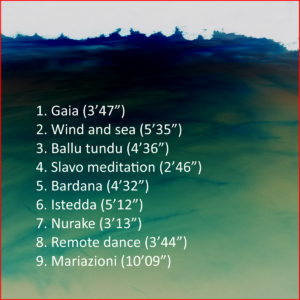AMMENTOS DE SONOS (Memories of sounds)
Traveling sound exhibition of Sardinian musical instruments
with demonstration conferences and guided tours
Regione Autonoma della Sardegna
Assessorato alla pubblica Istruzione,
Beni Culturali, Informazione, Sport e Spettacolo
Consulta Zonale del “Monte Acuto”
Associazione INTERARTES
Set up by Maurizio Puxeddu
from November 12 to December 23, 2001
Ozieri, Buddusò, Ittireddu, Ardara, Tula, Mores, Pattada, Alà dei Sardi, Nughedu S.Nicolò
Today it is not easy to oppose the loss of our historical, individual and collective memory. One of the ways to capture the attention of people, and in particular of young people, for the events and values of the past, is to stimulate their interest in their roots. Doing it – as the master Maurizio Puxeddu does – through the enchantment of sound, showing the traditional instruments, explaining them, making them listen and teaching them to build them, seems to me one of the best ways.
Annamaria Janin
AMMENTOS DE SONOS will bring on tour, in the nine municipalities belonging to the Zonal Council of “Monte Acuto”, an exhibition of objects related to the island’s musical culture (traditional Sardinian musical instruments, devices and sound toys, books, CDs, audio cassettes, video cassettes, 45 discs days, construction equipment and materials, musical instruments from the Mediterranean basin).
For a more in-depth knowledge of the content of the exhibition, demonstration conferences and guided tours are provided, where the tools will be illustrated, highlighting for each one, origin, materials, functions and music.
AMMENTOS DE SONOS, which already has numerous interventions in schools and municipalities in Sardinia, always attracting considerable interest thanks to its high cultural and popular value linked to the incredible heritage of our local musical culture, was the opportunity that allowed students of various schools in Sardinia and visitors in general to get in touch with traditional Sardinian culture or to continue the study of the specific topic.
The path in the exhibition will begin with sound toys and sound devices up to the actual musical instruments, through different “stations”.
In these “stations” the visitor will be able to focus his attention, thanks to the help of specially made explanatory panels and plates (with indication of the name, origin, manufacturer, date of construction of the exhibited object), on categories of instruments, on various sections dedicated to a particular aspect of musical culture.
There will also be a workstation dedicated to consulting, listening and viewing of books, audio CDs, video cassettes, audio cassettes and 45 days.
The INTERARTES Association is able to propose and implement (in addition to AMMENTOS DE SONOS) other projects related to the language and culture of Sardinia such as various types of workshops, spectacular and concert activities, UPDATE COURSES for teacher training, PRODUCTIONS of audio and VIDEO CDs, PRINT of PUBLICATIONS on topics related to traditional music and Sardinian culture in general.
To allow optimal use of the exhibition by school groups, it is recommended to book guided tours.
From the brochure of the initiative
